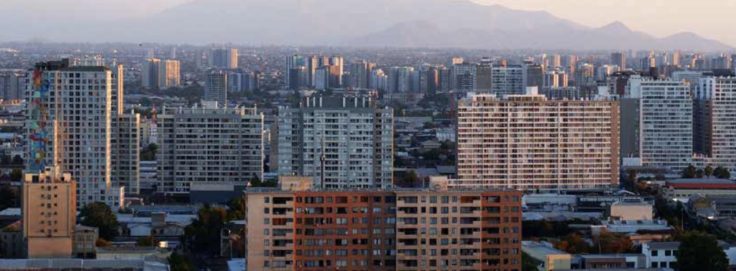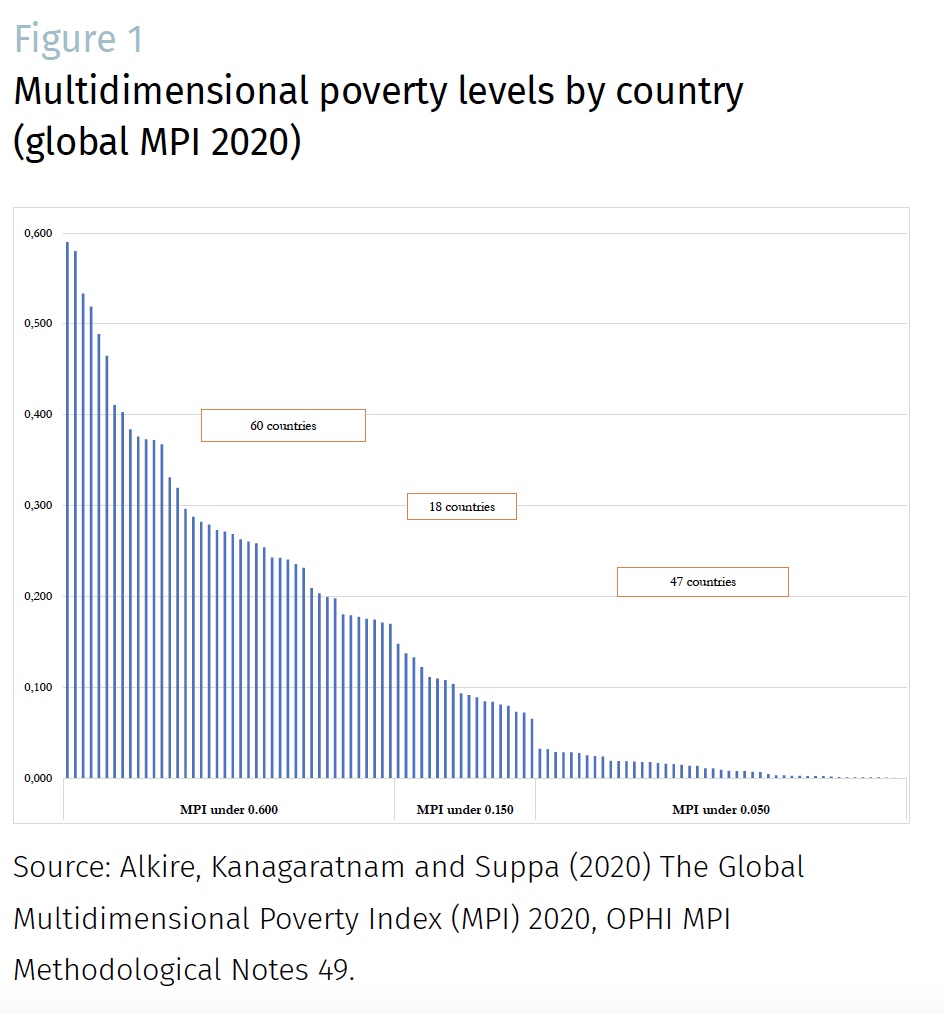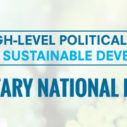
Search
Going beyond the global MPI: a new international measure for moderate poverty

The 2030 Agenda set clear goals for sustainable development. In order to ‘end poverty in all its forms everywhere’, countries need to secure long-term improvements across multiple areas of life including health, education, living standards, and employment, among others. This requires governments to go beyond reducing acute deprivations and work to guarantee enhanced livelihoods for all*.
Many countries have made progress in eliminating acute poverty
The global Multidimensional Poverty Index (gMPI) measures poverty in over 100 developing countries across all world regions. It captures poverty using ten indicators reflecting acute deprivations such as undernutrition, child mortality, lack of safe drinking water, lack of improved sanitation facility or no access to electricity. It provides an important tool for monitoring and policy design by assessing both the proportion of people who are multidimensionally poor and the intensity of their poverty, thus enabling policymakers to target deprivations in particular indicators using the index.
The latest gMPI findings show that many countries have successfully reduced the proportion of people living in acute multidimensional poverty, but large differences remain across nations with the MPI ranging from the lowest of 0.001 in Armenia to the highest of 0.590 in Niger. Despite many still facing harsh realities and lacking basic amenities, progress has been made with many leaving poverty behind, especially in upper middle-income countries. The reduction in the global number of acute poor over the years – particularly across regions and countries with low fertility and/or high growth rates – highlights the emergence of a new agenda for development, namely one related to moderate forms of poverty.
Of the 107 countries included in the gMPI (shown in Figure 1 below), 47 countries now have an MPI below 0.050. Among them, the incidence of poverty ranges from 0.19% (Armenia) to 8.64% (Iraq), while the intensity of poverty ranges from 34.23% (Seychelles) to 42.55% (Brazil). The majority of countries with low MPI are classified as upper or lower middle-income and also score high on the Human Development Index. Splitting them by UNDP world regions, 13 countries are located in the Europe and Central Asia region, ten in Latin America and Caribbean, six in the Arab States, five in East Asia and Pacific, one in South Asia and one in Sub-Saharan Africa.
The poverty levels in these countries are the result of years of policy achievements and increasing quality of life that minimised the presence of many basic deprivations associated with acute poverty.
For instance, in Iraq, only 0.1% of the population are deprived in a given indicator and identified as poor and only 1.4% of the people lack access to an improved sanitation and are multidimensionally poor.
In Peru, improvements over the years have reduced the proportion of people classified as poor who also lives in households where no one has completed six years of schooling to just 3.3%. In Serbia – and many countries in the Europe and Central Asia region – the proportion of the population deprived in a given indicator and identified as poor is less than 0.5% for all indicators, while the incidence of multidimensional poverty at the national level is below 3% for all countries in the Europe and Central Asia region, with the exception of Tajikistan.
In addition to low MPI countries, some urban areas in high MPI countries – for example Addis Ababa in Ethiopia, Maputo in Mozambique, or Lagos in Nigeria – have also achieved significantly lower levels of multidimensional poverty compared to the national average. Such variation in acute poverty levels across and within countries signals a turn towards a new field of measurement, aimed at capturing progress on indicators beyond those relating to the most basic conditions.
A new measure to capture higher levels of ambition for development
The indicators of the gMPI –focusing on acute deprivations such as malnutrition, child mortality or lack of clean drinking water– remain highly relevant for many countries seeking to reduce poverty and track progress on the SDGs, but they fall short of capturing higher ambitions. To ensure prolonged development, countries need to go beyond the acute deprivations captured in the gMPI and focus on additional SDG targets such as rates of secondary school attendance, access to healthcare, prevalence of non-communicable disease, or access to the internet or financial services, among others. In addition, measures of moderate poverty could aim to incorporate indicators related to gender equality, employment, human security or the environment, all of which are central to sustainable poverty reduction and embedded in the 2030 Agenda, but not currently covered in the gMPI structure.
The MMPI can identify an additional layer of people who suffer from moderate forms of multidimensional poverty.
There is a clear need for a comparable multidimensional poverty index that captures moderate forms of poverty and provides new incentives for governments to improve livelihoods. Such a global measure can help monitor progress towards increased development goals and capture complexities such as inequalities across genders.
Previous work by OPHI and UNDP Latin America explored an MPI for middle-income countries that included dimensions for health, education, living standards and employment. The pilot study covered six countries in the region, and trialed new indicators such as waste disposal, access to internet and technology, overcrowding, unemployment and social protection using data from national household surveys.
Besides presenting a first example of a moderate MPI, the collaboration provided a scoping of indicators and countries with intermediate levels of development. It concluded that the inclusion of new indicators and dimensions, particularly around health, employment and social protection, is largely dependent on data availability, with significant variation in availability and questions that impose limits on cross-country comparability.
In 2020, an alternative Moderate MPI (MMPI) has been presented by OPHI that builds on the structure of the gMPI to capture higher ambitions for sustainable development.
The new measure has been piloted in six middle income countries covering all world regions, with the trial MMPI including the same three dimensions – health, education, living standards – and 10 indicators as demonstrated by the gMPI, but with the inclusion of additional criteria as part of the indicators. For instance, the piloted years of schooling indicator now considers a household deprived if there is not at least one woman and one man of working age who have completed nine years of education – thus raising the bar and accounting for gendered differences in educational attainment. Other proposed additions to the MMPI include prevalence of obesity, health insurance coverage, piped water to premises, overcrowding, bank account ownership and school attendance up to class 10.
Retaining the same structure of the gMPI allows for the indices to be used together to monitor all forms of global poverty (extreme, acute, moderate) at a global scale. The MMPI can identify an additional layer of people who suffer from moderate forms of multidimensional poverty. This makes the new index highly relevant in countries with low poverty based on the gMPI, where development has minimised acute deprivations, but where many remain excluded and limited in their abilities to pursue a life free from all forms of poverty.
Although some data constraints remain, a global moderate MPI can provide a useful tool for countries who aim to eliminate more moderate deprivations to guarantee sustainable livelihoods for all.
* This article is based on OPHI Research in Progress 59a ‘Moderate Multidimensional Poverty Index: Paving the Way out of Poverty’ and the paper titled ‘Towards a Moderate Multidimensional Poverty Index: an application to Middle-Income Countries’ jointly produced by OPHI and UNDP Latin America. A version of Research in Progress 59a was presented as part of the seminar series co-hosted by OPHI, IIEP and HDRO.
This article was published in Dimensions 12

















